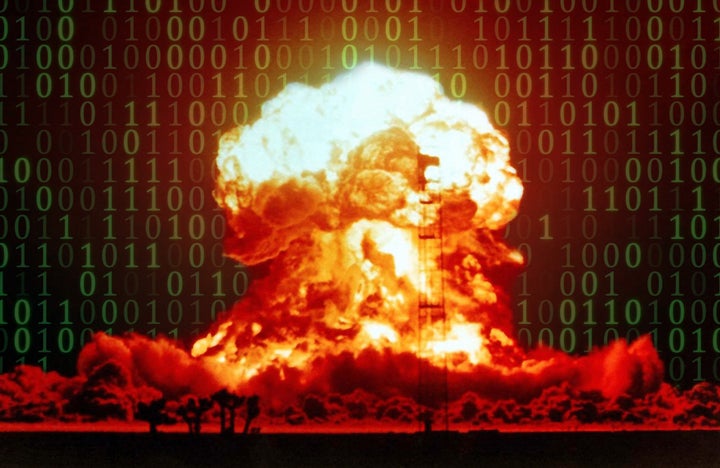
The year is 2028. A nuclear weapon just exploded in South Asia, unleashing chaos in a globe where nationalist movements and artificial intelligence have changed the dynamic of war. It is then, as the former national security adviser reflects four years later in his memoir, that the world was awoken to a harsh reality:
It took a mushroom cloud in a desert in South Asia to shake us from our complacency. I remember how the crisis between India and Pakistan started: The Second Indus Waters Treaty was abandoned by both sides, followed shortly by a series of explosions in New Delhi that the Indian government quickly attributed to Pakistan-based extremist groups. Islamabad denied involvement, but both sides began mobilizing their military forces. After a few confusing days of cyberattacks that disrupted the ability of both sides to understand what was happening, the situation escalated quickly. According to a subsequent investigation, artificial intelligence systems supporting the military decision makers made the crisis worse by misinterpreting signals meant to deter instead as signs of aggressive intent. The result was the first use of a nuclear weapon in a conflict since 1945.
With China’s help, the United States quickly moved to defuse the crisis ―we were lucky. The conflict barely missed escalating to a full nuclear exchange. President Smith shared the Nobel Peace Prize with the president of China that year.
This futuristic scenario, part of a larger report by the U.S. National Intelligence Council, is just a glimpse at what our world could look like if global trends continue to develop in their current fashion.
“Global Trends: The Paradox of Progress” was published in January and produced by myself and others at NIC ahead of the election of U.S. President Donald Trump. It consists of three scenarios, including the one excerpted above, spanning nearly two decades from present day to 2035. The sequences described are not meant to be predictions rather, as the report notes, they “explore how critical trends and choices might intersect to create different paths to the future.” The South Asian nuclear weapon scenario, from “Orbits,” describes the track the world seems to be on right now, with nationalism and domestic insecurity on the rise. In the second, “Islands,” nations turn inward. And the third, “Communities,” foresees dramatic new partnerships across the public-private divide.
The three sections use multiple time horizons to help explore the future from different perspectives, with the purpose of understanding how current patterns ― the reemergence of geopolitics, especially as China and Russia turn to external adventures to shore up internal legitimacy; economic growth slowing or stagnating; individuals and small groups becoming more and more empowered; technology progressing at a dizzying and unequal pace across the globe; conflicts over values; and people becoming more and more disconnected from their governments ― could unfold in the decades ahead. The scenarios illustrate what could ensue if one or several trends predominated, or if they interacted in particular ways.
“In one scenario, America is politically polarized and fiscally constrained -- and China reaps windfalls as a result.”
In “Orbits,” nationalist movements have taken hold around the world, and militaries build up amid increasing conflict over values and new technological possibilities. “Global Trends” eerily foreshadows Donald Trump’s “America First” approach, even though the NIC began sketching out the report well before his election. It portrays an America that is politically polarized and fiscally constrained, and thus much less active in international affairs. While the U.S. retrenches, China reaps windfalls; almost anything it does ― from climate change to global trade ― looks statesmanlike compared to the U.S.
In all the scenarios, Russia is the near-term wild card. The trends, especially economic and demographic, are running against it. Even now, President Vladimir Putin has done nothing to modernize the economy away from its dependence on fossil fuels. But in the next few years, Russia will have both the capability and the incentive to set in motion major crises — by acting ostensibly in support of threatened Russian speakers in the Baltic states, for example. Beyond that, Russia will be tempted to turn to the levers of power it will retain ― cyber and nuclear. And that nuclear explosion in South Asia is a reminder that there are other geopolitical clashes out there, and that they are also driven by ambition and animated by domestic insecurity.
If geopolitics in the context of economics drives “Orbits,” economics drives a second scenario, called “Islands.” The subtitle of “Global Trends” is “The Paradox of Progress.” The two decades before the economic crisis of 2008 were indeed a time of global progress without precedent: the combined forces of globalization and information technology lifted nearly 1 billion people out of poverty.
“In all the scenarios, Russia is the near-term wild card.”
But “Islands” imagines a world spanning up to nearly two decades from now that is still coping with the paradoxes of both trends. The IT revolution created wonderful tools for connecting people but so far has been most visible in separating them into echo chambers that only reinforce opinions and prejudices. Meanwhile, slow growth, aging populations and increasing inequality impels governments that are struggling to keep up with the demands of their citizens to turn inward. The backlash against globalization continues, and China and India remain mired in a middle income trap. Artificial intelligence and automation turn out to disrupt global job markets more than most economists expected. In the more near future, a global pandemic in 2023 required global cooperation but also sharpened the sense that nations need to focus on domestic issues first. The risk here is not war but a return to beggar-thy-neighbor economics that leaves all countries worse off.
The diminishing ability of national governments to meet the demands of their citizens compels some to simply give up in the third scenario, “Communities.” Some governments resort to rampant privatization — including some American cities that simply tear up paved roads once they are too potholed, inviting citizens to live with gravel roads or pay for repaving.
The empowerment of individuals and small groups is a theme of “Global Trends.” The negatives dominate in “Orbits” ― small groups of terrorists can create major mayhem, and collective action on major threats like climate change has become increasingly difficult. But the positives are also apparent in this future scenario — with enormous private wealth available for public purposes — the Gates Foundation spends more on health in Africa than the World Health Organization, for example.
“The future is in American hands.”
“Communities” imagines a messy outcome, one in which different forms of government emerge by trial and error. Enabled by continuing advances in information technology, agile states innovate in dramatic ways to meet the demands of their citizens. Power devolves in partnerships between cities, regions and communities that cross national borders. The change is so dramatic that a generation hence, it seems likely that many important issues today ― like the distinction between “public” and “private” ― will seem quaint.
In the end, the scenarios drive home the fact that the choices made by America and Americans right now will matter. The U.S. is still the biggest kid on the block, by far. The future is in American hands. Will the country turn inward, giving prominence to domestic issues over engagement in the world? Or will it engage abroad actively and creatively to protect its interests? Will it alter the way it governs, even dramatically, to take advantage of multiplying private stakeholders? The answer is hardly foreordained, and on it rests the future not just of the country, but of the entire world.

